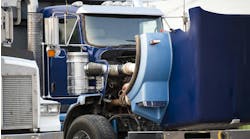High-speed imaging has the potential to save fuel and reduce inspections while increasing truck safety, according to the New York State Energy Research and Development Authority (NYSERDA), which has awarded $250,000 to International Electronic Machines (IEM) Corp. of Troy for the firm to continue developing equipment that inspects truck wheels and tires using infrared technology.
The Smart Infrared Inspection System (SIRIS) would be used to inspect truck tires, brakes and bearings at highway speeds. If successful, the technology could be used to signal trucks with mechanical issues to pull over at inspection sites, while trucks with no problems would be allowed to keep driving, which has the potential to save fuel and reduce greenhouse gas emissions while limiting inspection wait time, according to IEM. The technology’s early application was to look at trucks driving slowly through inspection sites, but this new generation will be used on trucks driving at highway speeds.
SIRIS looks for abnormal temperature variations, which indicate wear and possible damage. Early discovery of these problems prevents more significant damage — and possibly safety risks — down the road.
SIRIS was initially developed under a $1.4 million grant from the Federal Motor Carrier Safety Administration. NYSERDA contributed $250,000 in an earlier incentive, leveraging an additional $610,000 in private funding. The second round of funding, announced July 28, came about after IEM’s tests demonstrated the feasibility of the high-speed solution.
New York state conducts more than 100,000 truck and other commercial motor vehicle safety inspections each year. Many more than that number of commercial vehicles are pulled over to wait in an inspection queue, only to be waved through later. This results in as much as a half gallon of wasted fuel per truck and adds greenhouse gases to the atmosphere.
According to IEM, use of SIRIS could prevent the release of nearly 1,800 tons of carbon dioxide, 86,000 lbs. of nitrogen oxides and similar amounts of the other contaminants each year in New York alone. If adopted for use on a nationwide basis, high-speed SIRIS would reduce emissions of CO2 by more than 50,000 tons.
“Heavy-duty vehicles account for only 4 percent of the vehicles on the road, but consume 20% of the fuel,” said Francis J. Murray Jr., president & CEO of NYSERDA. “NYSERDA is partnering on dozens of projects that will help make the freight industry more energy efficient. This is yet another piece of the solution.”


